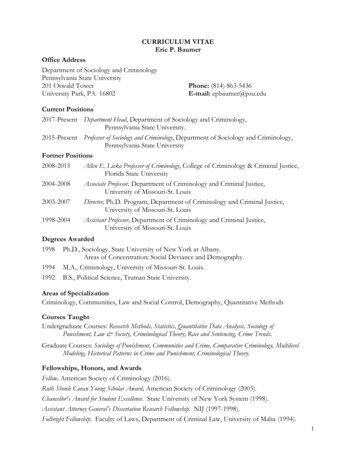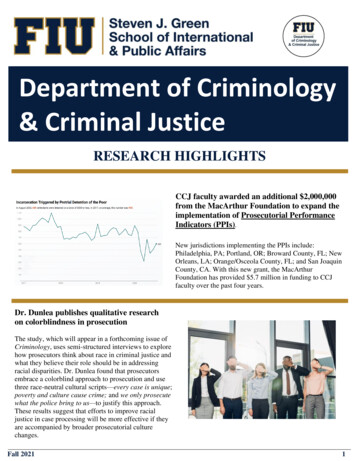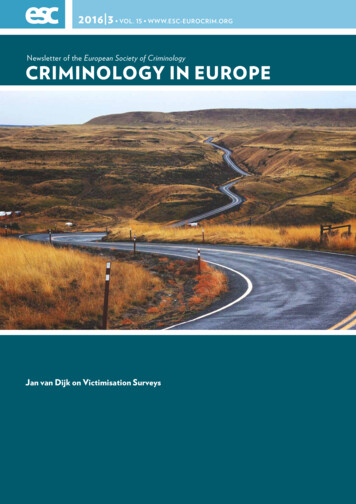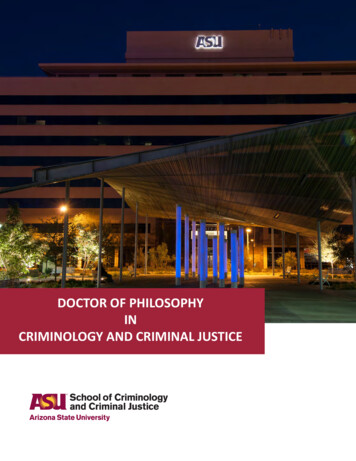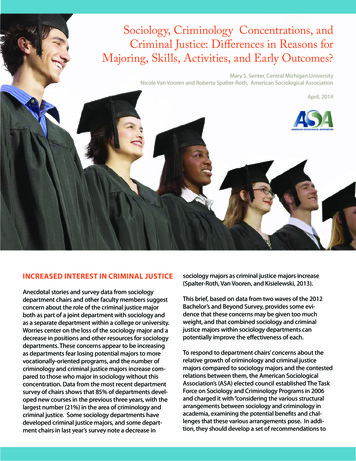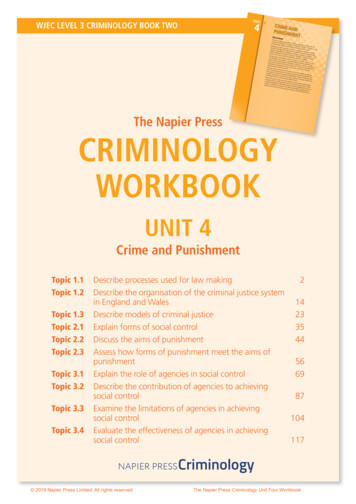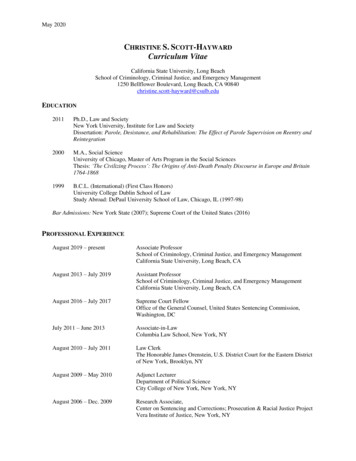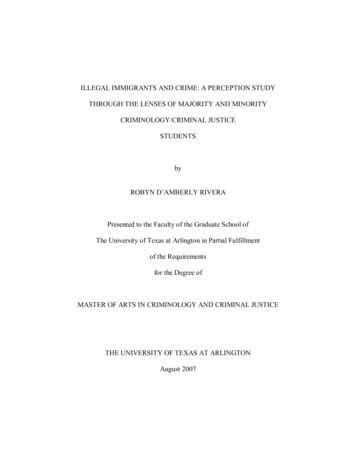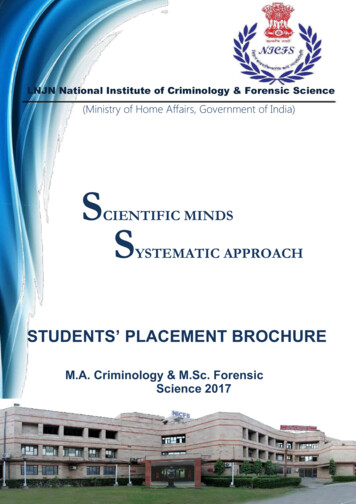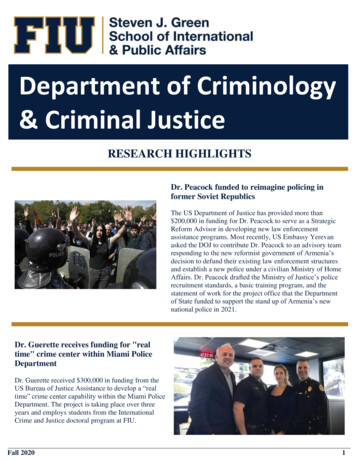
Transcription
Department of Criminology& Criminal JusticeRESEARCH HIGHLIGHTSDr. Peacock funded to reimagine policing informer Soviet RepublicsThe US Department of Justice has provided more than 200,000 in funding for Dr. Peacock to serve as a StrategicReform Advisor in developing new law enforcementassistance programs. Most recently, US Embassy Yerevanasked the DOJ to contribute Dr. Peacock to an advisory teamresponding to the new reformist government of Armenia’sdecision to defund their existing law enforcement structuresand establish a new police under a civilian Ministry of HomeAffairs. Dr. Peacock drafted the Ministry of Justice’s policerecruitment standards, a basic training program, and thestatement of work for the project office that the Departmentof State funded to support the stand up of Armenia’s newnational police in 2021.Dr. Guerette receives funding for "realtime" crime center within Miami PoliceDepartmentDr. Guerette received 300,000 in funding from theUS Bureau of Justice Assistance to develop a “realtime” crime center capability within the Miami PoliceDepartment. The project is taking place over threeyears and employs students from the InternationalCrime and Justice doctoral program at FIU.Fall 20201
Dr. Salas and Ana Carazo lead work in CostaRica to strengthen judicial responses toorganized crimePreviously funded by the Bureau of International Narcoticsand Law Enforcement (INL), Dr. Salas and Ana Carazo ledan effort to strengthen Costa Rica’s capacity to combat drugtrafficking and organized crime. This 2,500,000 grantinvolved, among other things, a reorganization of theProsecutor’s Office and a law draft for the establishment ofa specialized jurisdiction to try organized crime cases. Afterthe enactment of the specialized jurisdiction law, in 2019, asecond award for 536,000 was received to prepare CostaRica’s judicial branch to operate the special jurisdiction.CAJ completed a needs assessment, developed a tailoredprogram that addresses training needs and includes theinvestigation and prosecution of cybercrime, moneylaundering, corruption, human trafficking, and otherorganized crime activities, and is currently implementing it.FIU and Loyola University Chicago receive 2,000,000 in new funding from theMacArthur Foundation to implementProsecutorial Performance IndicatorsIn partnership with prosecutorial offices from Chicago,Milwaukee, Tampa, Jacksonville, Philadelphia, andCharleston, FIU and Loyola University at Chicago havedeveloped 55 measures of prosecutorial success andimplementation guides. These resources will helpprosecutors manage their offices, measure performanceover time, ensure the fairness of their decisions, andincrease transparency.Dr. Richardson awarded 120,000Bureau of Justice Assistance grant tohelp reduce violent crime in JacksonvilleThe partnership aims to address violence inJacksonville, FL, by using data to strengthen the StateAttorney’s Office’s (SAO’s) Targeted Prosecution Unitand implement a robust community engagement plan.Over the two-year grant, Dr. Richardson will work withthe SAO to develop performance indicators, enhanceinternal and external reporting mechanisms, trainattorneys to use data, and turn the SAO’s casemanagement system into an analytical tool.Fall 20202
Dr. Kutateladze and Ana Carazo completeNational Institute of Justice grant on antiLGBTQ hate crimesWith 500,000 in funding from the NIJ, FIU researchersinterviewed 400 hate crime victims in Miami, reviewedprosecutorial files, and interviewed practitioners toexamine the prevalence and nature of hate crimes, barriersto crime reporting, and post-victimization consequences.Nine out of 10 victims said that they were targetedbecause of their sexual orientation or gender identity; only15% of incidents were reported to the police. Friends’encouragement to report crime was the strongest predictorof hate crime reporting.Ph.D. candidate Sara McFann and Dr. Pirespublish systematic review on wildlife crimeresearchWildlife crime is an emerging topic of study withincriminology and criminal justice (CCJ). In this study,Ph.D. candidate Sara McFann and Dr. Pires provided thefirst-ever systematic review of the state of wildlife crimeresearch by CCJ scholars. The purpose was to describe andbetter understand how the study of wildlife crime hasevolved over time and where opportunities for expansionexist. Findings of the study, published in DeviantBehavior, show that quantitative studies are rare, with amajority being conceptual or theoretical in nature.Drs. Flexon, Stolzenberg, and D’Alessioexamine the effect of cannabis laws onopioid useThe study, published in the International Journal ofDrug Policy, examined the link between medicalmarijuana laws (MMLs) and opioid use. Drs.Flexon, Stolzenberg, and D’Alessio found thatopioid use is lower among individuals who reside instates that have legalized medical marijuana,suggesting that MMLs may serve to attenuate theconsequences of opioid overreliance.Fall 20203
Dr. Peacock coordinates FIU’s role in overseeing thedevelopment of cybersecurity studies in UkraineUSAID is providing up to 1,800,000 for FIU’s EmergingPreeminent Program Cybersecurity@FIU to assist in developingcurriculum and faculty in more than 12 new cybersecuritygraduate degree programs in Ukraine. In cooperation with theSchool of Computing and Information Sciences, the Departmentof Electrical and Computer Engineering, and Purdue University’sCenter for Education and Research in Information Assurance andSecurity, Dr. Peacock has developed three summer pedagogytraining programs that will focus on experiential learning againstreal cyber threats in a global network of training labs.Drs. Cohn and Kakar publish systematicreview of the effect of red light cameras(RLCs) on car crashesThe results of the systematic review indicate that RLCsare associated with a reduction in crash outcomes,although this varies by type of crash, and suggest areduction in red light violations. RLCs are associatedwith a 20% decrease in total injury crashes, a 24%decrease in right angle crashes, and a 29% decrease inright angle injury crashes. Conversely, RLCs areassociated with a 19% increase in rear end crashes. Therewas also some evidence that RLCs were associated witha large reduction in crashes due to red light violations.Dr. Pires co-authors edited volume on greenand conservation criminologyLimited attention has been directed toward quantitativeanalyses of relevant environmental crime, law and justiceconcerns. To address the gap, this edited collection featurescontributions that undertake empirical quantitative studiesof green/conservation crime and justice issues by bothconservation and green criminologists. The collectionhighlights the shared concerns of these groups withinimportant forms of ecological crime and victimization andillustrates the ways in which these approaches can beundertaken using quantitative methods.Fall 20204
Dr. Goddard serves as editor for a specialissue of the international journal CriticalCriminologyThe articles in the special issue examine what appear tobe less punitive iterations of juvenile justice policy andpractice. Written by scholars working in Canada, theUK and the US, the authors use their empirical findingsand theoretical insights to sketch a more detailed andelaborate picture of the range of controls over youngpeople in the present moment. The papers also assesshow recent shifts in juvenile justice might align ordiverge from broader visions of social justice.Dr. Zgoba wins the 2020 “Outstanding ArticleAward” from the Southern Criminal JusticeAssociationThe study, entitled “Assessing the impact of restrictivehousing on inmate post-release criminal behavior,” was ledby Dr. Zgoba. She and her colleagues found robustevidence that inmates placed in restrictive housing, alsoknown as administrative segregation, were more likely torecidivate after release than inmates not placed inrestrictive housing. The study was published in theAmerican Journal of Criminal Justice.Ph.D. graduate Erik Cruz leads study linkinglabor market conditions to frequency ofterrorist incidentsDr. Cruz, along with Drs. Stolzenberg and D’Alessio,used six years of data (2011–2016) drawn from theGlobal Terrorism Database and other sources for 127countries to conduct the study. A strong, negativerelationship between labor force participation and thefrequency of terrorist incidents across countries wasobserved. The study was published in the journal Studiesin Conflict & Terrorism.Fall 20205
Dr. Meldrum and Ph.D. candidate SadhikaSoor find adverse childhood events reduce selfcontrol among teensBased on an analysis of data collected on youth from bothMichigan and Florida, the study found that exposure to agreater variety of adverse experiences in childhood leads tolower levels of self-control. This was particularly truewhen the adverse experiences related to maltreatment. Forthe study, published in Criminal Justice and Behavior, Dr.Meldrum worked with Ph.D. candidate Sadhika Soor andresearchers from Florida State University, Wayne StateUniversity, and Eastern Michigan University.OTHER RECENT FACULTY* AND PH.D. STUDENT** PUBLICATIONSLiu, L.* (2020). Parole, neighborhood and reentryoutcomes: A contextualized analysis. International Journalof Offender Therapy and Comparative Criminology.OnlineFirst.Torres, C.**, D’Alessio, S. J.*, & Stolzenberg, L*.(2020). The effect of social, verbal, physical, andcyberbullying victimization on academic performance.Victims & Offenders, 15, 1-21.Meldrum, R.*, Stemen, D., & Kutateladze, B. L.*(2020). Progressive and traditional orientations toprosecution: An empirical assessment in four prosecutorialoffices. Criminal Justice and Behavior. OnlineFirst.Myers, R., Goddard, T.*, & Davidtz, J. (2020).Reconnecting youth: Beyond individualized programsand risks. Youth Justice. OnlineFirst.Richardson, R.* & Kutateladze, B. L.* (2020).Tempering expectations: A qualitative study ofprosecutorial reform. Journal of Research in Crime &Delinquency. OnlineFirst.Cruz, E.**, D’Alessio, S. J.*, & Stolzenberg, L.* (2020).The effect of maximum daily temperature on outdoorviolence. Crime & Delinquency. OnlineFirst.Arndt, M.**, Stolzenberg, L.*, & D’Alessio, S. J.*(2020). The effects of race and physical evidence on thelikelihood of arrest for homicide. Race and Justice.OnlineFirst.Zgoba, K. M.*, & Cowan, D. (2020). Sexual offenselegislation across the pond: A review of communitysentiment toward the United Kingdom’s implementation ofSarah’s law. Sexual Abuse, 32, 476-496.Partin, R. D.**, Stojakovic, N.**, Alqahtani, M.**,Meldrum, R. C.*, & Pires, S. F.* (2019). Low selfcontrol and environmental harm: A theoreticalperspective and empirical test. American Journal ofCriminal Justice. OnlineFirst.Kutateladze, B. L.*, & Leimberg, A.** (2019). Theinfluence of type of defense counsel on prosecutorialand judicial decision making in domestic violence cases.Crime & Delinquency, 65, 1623-1647.Guerette, R. T.*, Lee-Silcox, J.**, & Przeszlowski,K.** (2019). From research partner to embeddedcriminologist: A synthesized taxonomy and reflectionsfrom the field. Policing: A Journal of Policy andPractice. OnlineFirst.The Department of Criminology and Criminal Justice offers a Ph.D. in International Crime andJustice, a M.S. in Criminal Justice, a B.S. in Criminal Justice, and a B.S. in Crime Science. Foradditional information, please visit us online at ccj.fiu.edu.Fall 20206
The Department of Criminology and Criminal Justice offers a Ph.D. in International Crime and Justice, a M.S. in Criminal Justice, a B.S. in Criminal Justice, and a B.S. in Crime Science. For additional information, please visit us online at ccj.fiu.edu. Fall 2020 6
